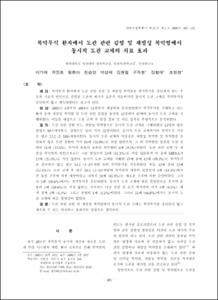KUMEL Repository
1. Journal Papers (연구논문)
1. School of Medicine (의과대학)
Dept. of Internal Medicine (내과학)
복막투석 환자에서 도관 관련 감염 및 재발성 복막염에서 동시적 도관 교체의 치료 효과
- Keimyung Author(s)
- Hwang, Eun Ah; Han, Seung Yeup; Park, Sung Bae; Kim, Hyun Chul; Kim, Hyoung Tae; Cho, Won Hyun
- Journal Title
- 대한신장학회지
- Issued Date
- 2006
- Volume
- 25
- Issue
- 2
- Abstract
- Background : Recurrent peritonitis and catheter-related infection, in which removal of the PD catheter and temporary hemodialysis are required, are the main cause of limited technical survival in peritoneal dialysis (PD). The aim of this study was to verify whether the simultaneous catheter removal and replacement (SRR) is feasible and safe in patients with recurrent peritonitis and catheter-related infection.
Methods : From January 2001 to December 2004, We performed 47 SRR in 42 PD patients for the treatment of recurrent peritonitis and catheter-related infection to avoid the interruption of PD.
Results : Indications for SRR were recurrent peritonitis in 16 (34.0%), catheter infection without peritonitis in 16 (34.0%), catheter infection with peritonitis in 11 (23.5%) and peritonitis with dialysate leakage in 4 (8.5%). SRR was successful in 89.4%. However, SRR was failed in 10.6% due to persistent tunnel infection in three, drainage failure and hernia in each one. PD was continued after SRR during 14.5±11.8 months and subsequent catheter longevity ranged from 3 to 47 months. The most common causative organism of recurrent peritonitis and catheter-related infection was MRSA (25.5%). Subsequent peritonitis occurred in 52.4% of patients with the mean of 10.5±9.6 months after SRR. However, 81.8% of subsequent peritonitis were due to new organisms. Postoperative complications occurred in 16 cases (34.0%) including five cases with dialysate leakage, four with persistent tunnel infection, four with early peritonitis, two with drainage failure and one with bleeding.
Conclusion: We conclude that SRR is a safe and effective procedure in patients with recurrent peritonitis and catheter-related infection without the interruption of PD.
배 경: 복막투석 환자에게 도관 관련 감염 및 재발성 복막염은 복막투석을 중단하게 하는 주 요한 기술적 원인으로 감염된 도관의 제거가 표준적 치료이지만 동시적 도관 교체로 복막투석을 중단하지 않고 계속하였다는 보고가 있다.
방 법 : 20이년 1월부터 2004년 12월까지 계명의대 동산병원에서 복막투석을 시행하고 있는 환자 중에 재발성 복막염 및 도관 관련 감염을 동반한 42명에서 47예의 동시적 도관 교체를 시 행하였다. 이들을 대상으로 도관 교체 후 임상 경과 및 치료 성적을 후향적으로 분석하였다.
결 과:도관 관련 감염 또는 재발성 복막염으로 동시적 도관 교체를 시행하였던 42명의 평균 연령은 60.7세이었고, 성별로는 남녀 각각 21명이었다. 동시적 도관 교체까지의 복막투석 기간 은 평균 33.2 (1-106)개월이었다. 동시적 도관 교체의 적응증은 재발성 복막염 및 복막염을 동 반하지 않은 도관 감염이 각각 16예 (34.0%)로 가장 많았으며, 그 외 복막염을 동반한 도관 감 염이 11예 (23.5%), 투석액 유출이 동반된 복막염이 4예 (8.5%)이었다. 도관 관련 감염 및 재 발성 복막염의 원인균으로는 그람 양성균이 24예 (51.1%)로 가장 많았으며 이 중에 MRSA가 12예 (25.5%)로 가장 많았다. 동시적 도관 교체를 시행한 47예 중에 42예 (89.4%)는 복막투석 을 중단하지 않고 평균 14.5 (3-47)개월 동안 복막투석을 지속하였다. 이들 42예 중에 22예 (52.4%)는 도관 교체 후 평균 10.5 (2-43)개월에 복막염의 재발이 있었으나 4예 (18.2%)에서 만 동일 균주에 의한 재발이었고 나머지 18예 (81.8%)는 새로운 균주에 의한 감염이었다. 그러 나 5예 (10.6%)에서는 복막투석을 중단하였다. 동시적 도관 교체에 따른 합병증으로 투석액 유 출이 5예 (10.6%)로 가장 많았고, 지속되는 터널 감염 및 초기 복막염이 각각 4예 (8.5%), 배 액 장애 2예 (4.3%) 그리고 출혈이 1예 (2.1%)이었다. 그러나 31예 (66.0%)에서는 동시적 도 관 교체에 따른 합병증이 없었다.
결 론:도관 관련 감염 및 재발성 복막염에서 동시적 도관 교체는 복막투석을 중단하지 않고 계속할 수 있는 안전하고 효과적인 방법으로 생각된다.
- Alternative Title
- The Effect of Simultaneous Catheter Removal and Replacement for Recurrent Peritonitis and Catheter-related Infections in Peritoneal Dialysis Patients
- Publisher
- School of Medicine
- Citation
- 이기태 et al. (2006). 복막투석 환자에서 도관 관련 감염 및 재발성 복막염에서 동시적 도관 교체의 치료 효과. 대한신장학회지, 25(2), 205–211.
- Type
- Article
- ISSN
- 1225-0015
- 파일 목록
-
-
Download
 oak-bbb-02422.pdf
기타 데이터 / 196.45 kB / Adobe PDF
oak-bbb-02422.pdf
기타 데이터 / 196.45 kB / Adobe PDF
-
Items in Repository are protected by copyright, with all rights reserved, unless otherwise indicated.